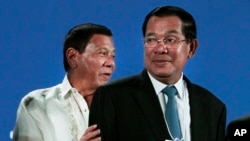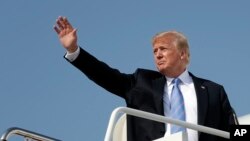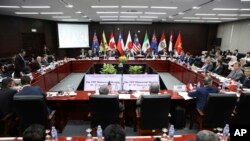In the two decades since Asean was formed, it has failed to uphold its original mandate of maintaining cohesion among its members, experts have said.
The rise of China, the United States’ uncertain position on the region and instability in its member states have led some scholars to suggest that the 10-member body may be on the verge of breaking up.
“The ten countries can’t get together because Asean has been operated under consensus,” Dr. Ja Ian Chong, associate professor of political science at the National University of Singapore, said during a talk at the East West Center in Washington D.C. recently.
For decades, China and the United States had vied for dominance in the region, but in recent years China has been seen as coming out as the winner, while the U.S. administration under President Donald Trump has seemingly lost interest.
China has launched several new initiatives, such as the Belt and Road Initiative (BRI) and the Asian Infrastructure Investment Bank (AIIB) in a bid to strengthen its development presence. These initiatives are seen as a setback for the United States, which is seen as turning its back on the Obama administration’s Pivot to Asia strategy.
After assuming office last year, Trump withdrew the U.S. from the Trans-Pacific Partnership (TPP), which included four Asean members: Brunei, Malaysia, Singapore, and Vietnam. But the region is also divided between those nations seen as “pro-China” and those seen as “autonomous”, according to Dr. David Denoon, a professor of politics and economics and director of the Center on U.S.-China Relations at New York University.
"China is trying to split the Asean states into two groups. One group that is pro-China, which includes Myanmar, Thailand, Laos and Cambodia, and the other group, which sort of fits the original design of the Asean 10 and they stress a more autonomous position, so that includes Vietnam, Malaysia, Singapore, Indonesia and Brunei, “ he said. “The Philippines is sort of a mixed case. It looks like the Philippines is trying to move closer to China, but of course, it still has a defense treaty with the United States.”
Chinese Influence
Analysts note that if Asean is unable to form a coherent voice on the international stage it could become vulnerable to outside influences.
"Should Asean or Southeast Asia be less able to work together or to hold together, what that could mean is that there is more room for major powers’ contestation,” said Chong.
He added that after Cambodia, Myanmar, Laos and Vietnam had joined the bloc, collective decision making had become more difficult because the new member states needed large-scale infrastructure investment that China was willing to provide. China was thus able to put “pressures on Asean as an organization and on the ability of Southeast Asian governments to work together collectively.”
Experts also believe that Chinese power will rapidly expand through the creation of the AIIB, with all 10 Asean states becoming members of the institution on its formation in 2014. At the World Economic Forum in Asia, held in Phnom Penh in May last year, AIIB President Jin Liqun said the bank would provide “strong support” to Asean states.
Denoon notes that Chinese influence in Southeast Asia was broadly “positive” in terms of economic development but “negative” in terms of the security situation.
“China has both positive and negative influence. The positive influence is trade that Southeast Asia exports so much of its goods to China, but at the same time, China is now pressing Southeast Asia on its military desires, and that means that Southeast Asian countries are getting mixed messages. The positive message is economics; the negative message is military,” Denoon said.
Dr. Vannarith Chheang, associate fellow at the ISEAS-Yusof Ishak Institute, said that “artificial island building in the South China Sea” is also a threat to peace in the region, referring to China’s strategy in the South China Sea.
Washington’s Commitments
While the Trump administration has not clearly defined a foreign policy with Southeast Asia, Denoon argues that “the United States remains committed to the Asean region” because the region is vital to America.
“Southeast Asia is very important to the United States strategically because the control of the Malacca Straight means the shipping from the Pacific to the Indian Ocean, and if China was to have control of both sides of the Malacca Straight; let’s say Malaysia and Indonesia were to move closer to China, that would be very bad for the United States,” Denoon said.
He added: “The US has no desire to control territory in Southeast Asia, but we do want freedom of the seas, freedom of access.”
However, Chheang does not expect the Trump administration to become more actively involved in the region, hoping instead that the next U.S. administration will revive its commitment to “challenge” China.
“We have seen that the US [under Trump] has less commitment [in Southeast Asia], but after the Trump administration, the US’s policy could be changed because US policy is not solely based on the Trump administration. The US can return to get involved in the region in order to strengthen its power to challenge China. I think the United States does not abandon Southeast Asia,” Chheang said.
Asean Choices
Chong of the National University of Singapore suggested that states that were not willing to accept Chinese dominance, such as Malaysia, Indonesia, Singapore and Vietnam, could form a subset of Asean states that seek better opportunities elsewhere whilst remaining part of Asean.
"Higher capacity states looking at other partners apart from Asean, so we have the high capacity states looking for more high-quality cooperative arrangements with partners that are not in Southeast Asia,” said Chong.
The TPP, a decade-old trade agreement originally signed by twelve nations on both sides of the Pacific Ocean in 2016, was abandoned by the United States early last year.
In the wake of America’s withdrawal, the other eleven countries of the TPP, including four Asean states – namely Brunei, Malaysia, Singapore and Vietnam, which analysts believe are more “autonomous” among Asean members – signed a revised landmark trade agreement, the Comprehensive and Progressive Agreement for Trans-Pacific Partnership (CPTPP), without the participation of the United States, on March 8.
Even though Denoon argues that there is no “real alternative” to the United States if Southeast Asians want to “balance the charm” of China, he agrees that India could act as a new actor to “supplement” and “work” with the United States to provide a defense against China’s increasing power in the region.
“Now India is growing in importance. India now has two aircraft carriers; has very good air forces; India is very concerned about China, so if Southeast Asians are willing to have more cooperative relationships with India, then it’s possible that India could supplement and work with the United States,” said Denoon.
Scholars believe that despite their own different needs and interests, and since they do not want to “antagonize China” in terms of economic interests, all Asean nations should move towards autonomy.
This “autonomy,” as stressed by Denoon, is “the best long-run alternative for Southeast Asia,” but, as he notes, Asean is still far from reaching that goal given its past experience of not being “able to develop a kind of cohesion that they originally hoped for.”
“If the Philippines, Vietnam, Indonesia, Singapore and Malaysia all want to be more autonomous, then the question is will Asean stay together as a group or will it essentially function as two sub-groups? So that is the uncertain question for the future.”










